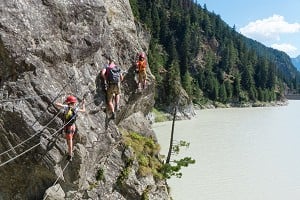
Please note: these are my opinions based on six weeks' experience over four years. I don't claim to be an expert on the area (but it may sound like it when I'm drunk). This is a first draft: comments, feedback and above all, additions would be more than welcome. For more information see the Dolomites destination article.
Updated on 20/12/14
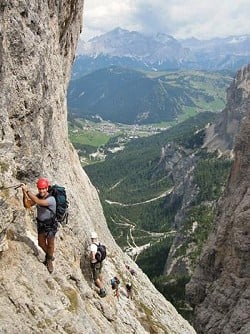
Q: Why should I go?
A: It's a superb area for a climber who wants to explore high mountains without the complications of snow and ice climbing. Everything is easier than it looks, so you can get into really interesting and spectacular locations without too much difficulty. This is the birth place of the Via Ferrata, but there are also long classic routes, sports climbs of all standards and even bouldering if you're that way inclined.
Q: When should I go?
A: Beginning of June to end of September. However at the start of that period there may still be snow left over from the winter, and towards the latter half of September it may get too cold to do much climbing. Also you may wish to avoid mid-July to late August" it's very busy and also there's an increased risk of thunderstorms
Q: What is the weather like?
A: As it is a mountain region, the Dolomites' weather can be volatile and you are unlikely to get more than three or four days of continous good weather. Early starts can often play dividends as a sunny morning often leads to a buildup of cloud and a thunderstorm. However bad weather tends to pass quickly. A thunderstorm overnight can lead to a misty morning, which then clears to a perfect day. Such days are often the best: the rock dries quickly but many people are put off and you can have routes almost to yourself. Snow is possible at virtually any time of year.
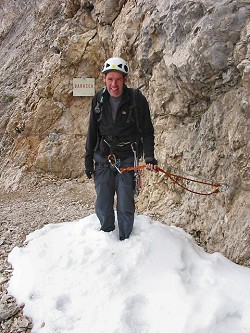
Q: How do I get there?
A: Some people drive, but it's about 12 hours' driving time from Calais. Plus, do you really want to drive on narrow mountain roads in a right hand drive car? The closest airports in Italy are Treviso and Venice (Marco Polo), but Verona, Brescia and Bergamo are all within three hours. Alternatively there's Innsbruck in Austria. Low-cost airlines such as BMIBaby, Ryanair and Easyjet all use the Italian airports, but watch out for the baggage allowance.
Q: Hire Car or Public transport?
A: Hire cars are expensive, minimum £150 per week, but BMC members can get a discount through Hertz. There is a good bus network that is pretty reliable, but you might find yourself somewhat limited in range; it's also difficult to make an early start, and you might get stuck if you have an epic.
Q: Where should I/we stay?
A: Cortina is the main town in the region, but smaller towns like Corvara, Canazei, Arabba and Misurina might be better locations depending upon which area you are going to. There are a number of campsites, but having seen hailstones the size of golf balls coming down, I wouldn't recommend it. There's an excellent network of refuges, some accessible by car, others more remote and with a variety of accommodation from private rooms to communal bunkrooms.
Regular UKC user Mike Kann is very knowlegable about the area and runs a nice set of appartments (Casa-Alfredino) near the Marmolada.
For a full list of CAI huts see http://proxy.provincia.ra.it/cailugo/asp/tabelle/frame-tabelle.asp?pagina=tabelle&language=inglese
For those who like a bit more comfort, you can get catered chalets in Arabba and Pedraces, along with organising walking and Via Ferrata trips at http://www.colletts.co.uk.
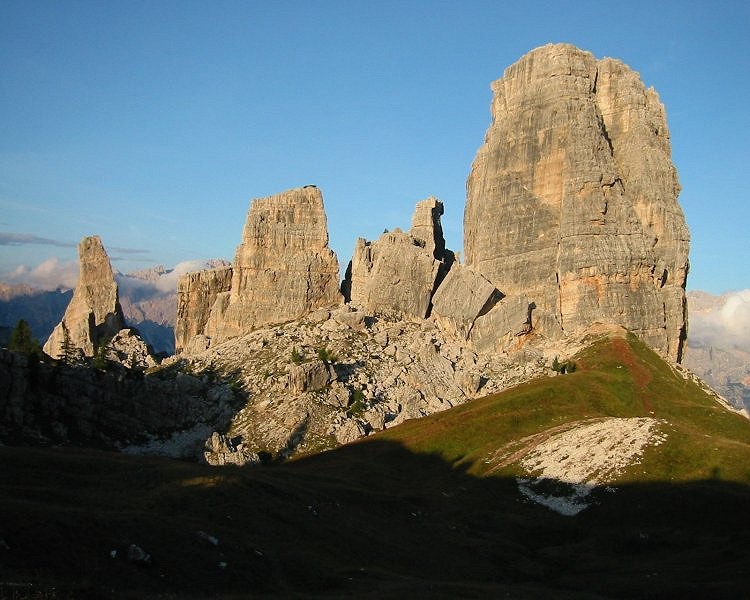
Q: What are Via Ferrata?
A: In Italian, "Iron Way". They're scrambles or easy climbs that are equipped with cables for safety, and possibly ladders and bridges according to the terrain. The cables are fixed to the rock at regular intervals, but these intervals can vary from 2 to 10m. Some people like to climb the rock wherever possible; others will use the cables as a handrail. Either way it's an exciting and popular sport that offers a quick and safe way of moving through the sort of terrain that would normally require ropes.
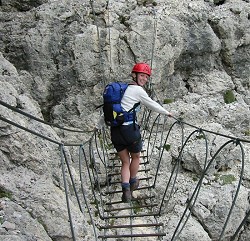
Q: What equipment do I need?
A: You'll need your harness and helmet, but not your rock boots or chalk bag. However there is one essential piece of specialised equipment - a shock absorption system that links your harness to the cables, usually referred to as a set of tails. Traditionally this was a 2m length of rope, with a krab at either end and a friction device called a KISA (Kinetic Impact Shock Absorber). This goes in the middle of the rope and attaches to the harness. Each time you come to a bolt fixing the cable to the rock, you clip one krab on the cable beyond it and unclip the other. In the event of a fall, the KISA will slide along the rope, absorbing the shock gradually. More recently manufacturers like Petzl have introduced the Y-shaped system, such as the Zyper-Y. Details of these, and loads of other useful info, can be found on the Petzl website: http://www.Petzl.com
Q: Which system should I use?
A: The advantage of the Petzl systems is that they work if either or both of the krabs are clipped into the cable, whereas with the KISA system you should only have one krab clipped, except when passing a bolt.
However the advantage of the KISA system is that you can customise the length of the rope, allowing you to move further away from the cables, which is useful if you're a purist who likes to climb the rock.

Q: Can I use slings rather than a KISA system?
A: No, absolutely not. If, for example, you were 4m above a bolt (a fairly standard gap) and fell onto a 1m sling, you would take a factor 5 fall on something which doesn't stretch. (If you don't know about fall factors: a fall factor of 1 or more is considered serious on a dynamic - ie stretchy - rope, and often given as grounds to retire it from active duty.) The dramatic deceleration means that if neither the sling nor the cable breaks, your back probably will, and this can really put a dampener on your whole day. You may think there's no risk of you falling, but someone above you could fall on to you, or dislodge some rocks.
The krabs are specialised as well, being AutoLocking. A simple snapgate is neither sturdy nor secure enough, and a screwgate is too cumbersome.
Q: Is it possible to hire VF kits?
A: Yes - most of the towns will have at least one sports shop and they all seem to hire out the full kit - helmet, harness and a set of tails, or whichever part of it you need. You should be able to hire a set of tails for around 5 euros a day, or buy them for around 35 euros. The Petzl system is more expensive, between 50 and 70 euros.
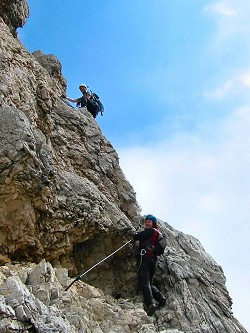
Q: Could you recommend some routes?
- Grade 2 (Beginners)
- TchirSpitz (Passo Gardena)
- Grade 3 (Intermediate)
- Tridentina (Passo Gardena)
- Piz de Lech (Corvara)
- Grade 4 (Advanced)
- Trincee (Arraba)
- Possnecker(Passo Sella)
- Grade 5 (Long and Hard!)
- Punta Anna/Tofana (Cortina)
- Tommaselli (Passo Falzerago)
- Eterna Brigata (Mamolada)
Q: What is a good grade to start at?
A: I started on a 5, but in the company of an expert. A climber who is fit and can lead VS will have no problems on any of the routes in the Dolomites, but it is worth doing an easy one (Grade 2 or 3) so as to get used to the gear, the techniques and the exposure!
Q: Which guidebook should I buy?
A: For Via Ferrata, Rockfax have recently published The Dolomites : Rock Climbs and Via Ferrata which covers the majorty of via ferrata in the area as well as trad and sport climbing. Cicerone have also published 2 excellent volumes by John Smith and Graham Fletcher. The first covering the North Central & East area (and all the ones I've recomended), the second covering the West, Brenta and Lake Garda area.
For climbing, The Dolomites : Rock Climbs and Via Ferrata covers the central Dolomites. There is also 100 Classic Dolomite Climbs for those wanting an overview of the classic routes.
My advice is to photocopy the topos of any routes you intend to climb before you go out there, carrying books up the routes is not much fun!
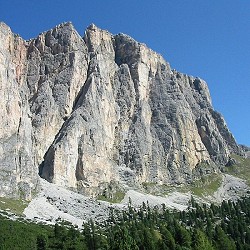
Q: Where should I go for climbing?
A: The Cinque Torri is a good place to start - easy access, two refuges close by, climbs of all grades, facing in all directions, and both sport and multi-pitch trad. The latter will also give you the opportunity to polish up on your abseiling skills. The Sella towers are a bit bigger and generally harder trad climbing - The Trenker crack is a classic grade V (ie VS).
Falzerago Towers, Vajolet Towers, Tofana de Rozes, Punta Fiammes, Tre Cima, Civetta you name 'em, I've not done 'em, but I'd like to!
Q: What gear do I need? A: A helmet is essential - there is a lot of loose rock around. Most people recommend taking 2 50m routes rather than a single rope, the main reason being that on some routes abseil stations and belay points are 50m apart. Take a good selection of nuts, a few hexes and plenty of slings. Friends can be useful if you're trying to move quickly, but generally I've found them an unnecessary weight. The amount of fixed gear varies from route to route - bolt belays are fairly common, as are pegs. Often you'll find that the crux section has plenty of gear (sometimes far more than you need), but as soon as you reach easier ground it disappears and becomes less obvious where the route goes.
Q: Is there any sports climbing? A: Some would mock you for that question, but sports climbing is a good option when the weather is a bit doubtful, or it's cold, or you're having a short day, or you've used up your allowance of epics. Apart from Cinque Torri, there an excellent slab at Saas di Stria with routes up to F6a (same guide book). At the Sella Pass there is a collection of huge boulders called the Citta di Saas, and there's even more stuff futher down the valley. But beware, the Italians are not generous with their grades, particularly on steep routes, and you are at altitude.
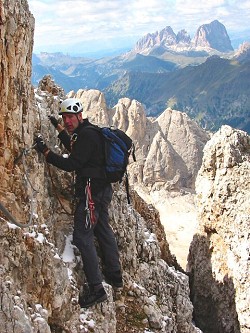
Q: How do I avoid an epic?
A: Remember these rules:
- Set off early
- Check where the route goes before you get to the bottom of the crag - what may look obvious on a photo and from a distance, can look a bit less obvious when you are directly below it
- If your descent involves a cable car, check the time of the last one
- Carry a torch
Related UKC Articles:
The Dolomites by James Rushforth
Climbing the Comici by James Rushforth
The Brandler Hasse by Jack Geldard
Dolomites - Ice, Mixed and Drytooling by James Rushforth
ROCKFAX - Dolomites : Rock Climbs and Via Ferrata Reviewed by Tom Ripley
thumb(90443, TRUE, "right") ?>
Chris Moor is a regular contributor to UKClimbing. He describes himself as "Tall, a bit too heavy and completely lacking in upper body strength."

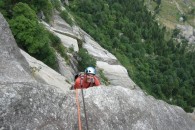

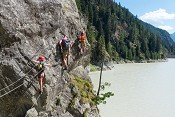
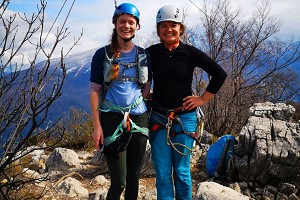
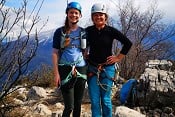
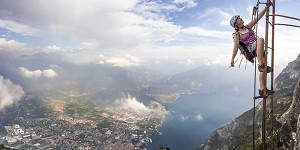




Comments